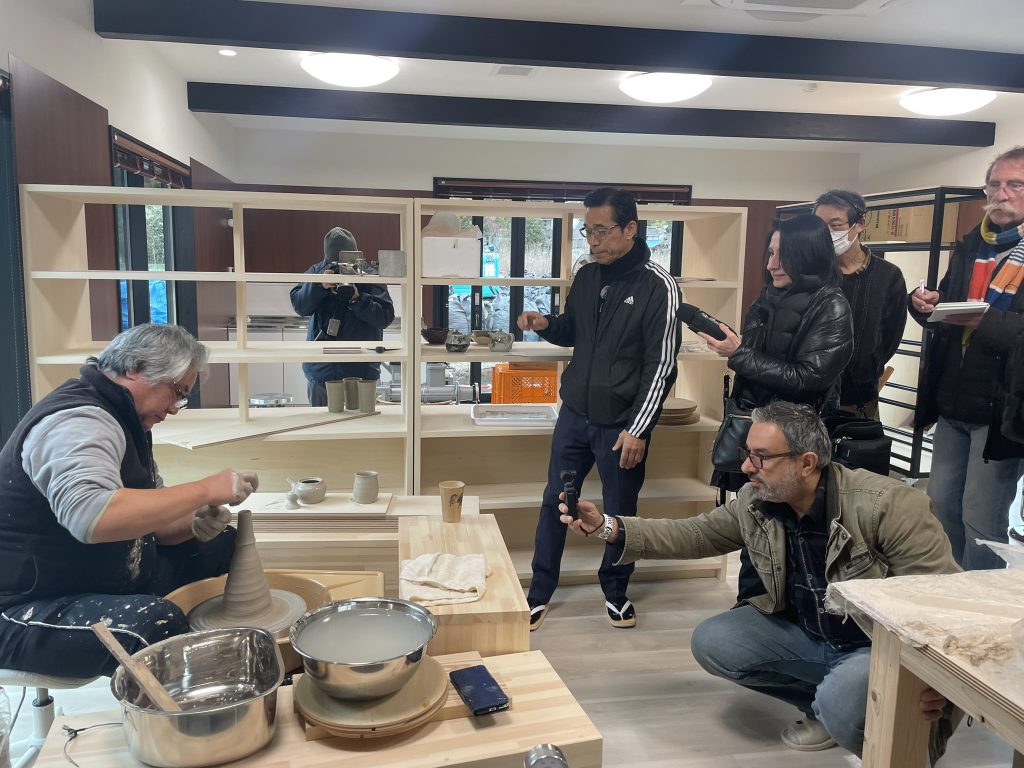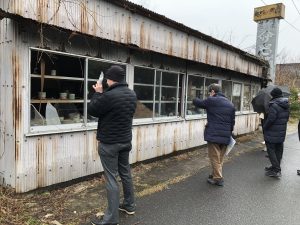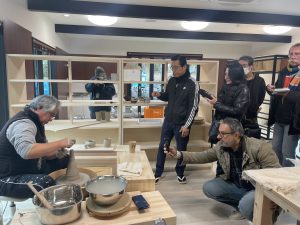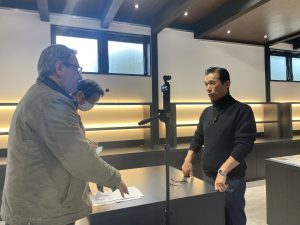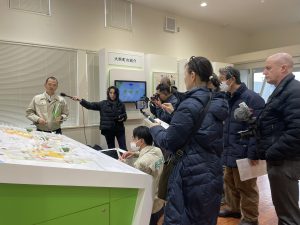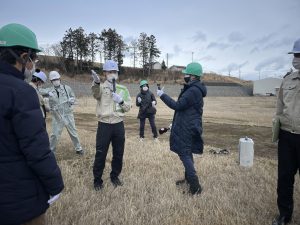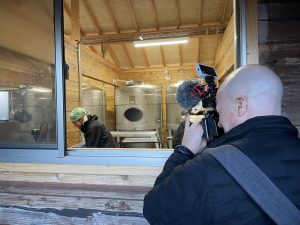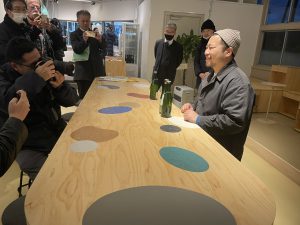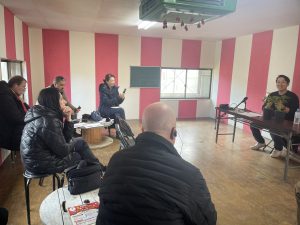実施日 : 2024年02月27日(火) - 28日(水)
Report: Fukushima Press Tour
投稿日 : 2024年03月26日
In this March, 13 years have passed since the Great East Japan Earthquake and the TEPCO Fukushima Daiichi Nuclear Power Station accident. This tour visited areas that have made a new start with the lifting of evacuation orders, covering efforts by companies to create jobs and contribute to rebuilding the region, and residents doing their best to preserve local traditional industries. The tour also visited two entrepreneurs who moved to Fukushima from outside the prefecture to learn about their efforts towards community building and stimulating local industries.
A total of six journalists participated in the tour, from media organizations based out of France, Qatar, Singapore, Switzerland, and the US.
*This press tour was sponsored by the Ministry of the Environment, Japan and planned and operated by the FPCJ.
*For more details on the tour stops, see the press tour notice.
[Day 1]
<Obori Soma Ware Kiln: Toukichirougama (Obori, Namie)>
The press tour visited the Obori district in Namie Town, the birthplace of Obori Soma ware, a traditional craft product with over 300 years of history, where in March 2023 evacuation orders were lifted for the first time in approximately twelve years. After seeing the area in which over 20 potteries operated before the disaster, the tour visited Toukichirougama, the only pottery that resumed operations in Obori after the evacuation orders were lifted.
The journalists heard from Mr. KONDO Manabu about the characteristics of Obori Soma ware, such as its blue crack patterns and double-layered structure, and about why he decided to rebuild his kiln in Obori and start working from there again. The journalists also had the opportunity to film and photograph an artisan making dishes and teapots using a pottery wheel.
<Interim Storage Facility>
The journalists visited the Interim Storage Facility, which was constructed to manage and store safely and in an integrated manner, removed soil and waste arising from the decontamination activities in Fukushima Prefecture, until they will be finally disposed of outside Fukushima Prefecture within 30 years after the start of its transportation to the Interim Storage Facility. At the Interim Storage Facility Information Center, an official from the Ministry of the Environment gave an overview of the facility and the places the tour would visit, followed by the journalists taking a bus into the premise of the Interim Storage Facility. In addition to seeing the Soil Storage Facility, where the soil is stored after any large inflammable materials or flammable materials (such as plants) have been separated, the group was able to see the Fukushima Daiichi Nuclear Power Station approximately two kilometers away from a temporary observation deck built along the evacuated Sunlight Okuma senior care facility located in the grounds of the Interim Storage Facility. The tour also saw from the bus a demonstration project for reusing the removed soil for road embankments.
The journalists asked questions such as how the radiation levels in the facility are monitored, and the basis for setting the radioactivity concentration of removed soil to be reused at 8,000 Bq/kg or less.
<haccoba Namie Brewery (Namie)/Odaka Station Brewery & Public Market (Minamisoma)>
To cover efforts by people who moved from outside the prefecture to support reconstruction and solving local issues by starting new businesses, the tour visited haccoba, a craft sake brewery established by Mr. SATO Taisuke, who moved to Minamisoma City from Tokyo. At the Namie brewery, Mr. SATO explained why he decided to start making sake in Fukushima, and the journalists had the chance to film and photograph sake being brewed with rice grown in Minamisoma. Afterwards, the tour went to the Odaka Station Brewery & Public Market using the JR Odaka Station building, where they saw the brewing equipment, community space, and sales area with local specialties, followed by those journalists who were interested in tasting the craft sake.
The journalists asked Mr. SATO about what he wanted to achieve by making sake in a disaster-affected area, what efforts were necessary to dispel rumors about Fukushima products, and what support there was from local governments when starting his business.
[Day 2]
<Ministry of the Environment Briefing>
Ministry of the Environment officials explained initiatives for decontamination with the goal of lifting evacuation orders, the recycling of removed soil, and final disposal of the removed soil outside the prefecture.
The journalists asked questions about the feasibility of the final disposal of the removed soil outside the prefecture, which is supposed to be completed by March 2045, and the rational behind the plan.
<Asanonenshi Co., Ltd.: Futaba Super Zero Mill (Futaba)>
The tour visited Futaba Town, where in August 2022 evacuation orders were partially lifted for its Restricted Area (specifically, for the Specified Reconstruction and Revitalization Base Area), and covered the Futaba Super Zero Mill, a twisted yarn factory which is hoped to create jobs and interaction between residents. After hearing from Asanonenshi Co., Ltd. company president Mr. ASANO Masami about the project and why the company, with its head office located in Gifu Prefecture, opened this factory in Futaba, the journalists saw the production line for the Super Zero twisted yarn, which uses water-soluble threads and has excellent water absorption properties. The journalists also spoke with two young employees at the Futaba Super Zero Mill, who moved to Futaba from Iwaki City, Fukushima.
The journalists asked Mr. ASANO about the overseas sales strategy for Super Zero and his feelings towards the reconstruction of Futaba, as well as asking the young employees about why they decided to join the company, and how they felt about living and working near the nuclear power station.
<Anthurium Farm: smile farm (Kawamata)>
The tour visited Kawamata Town, where efforts were made to support reconstruction by making anthurium cultivation into a new local industry after the disaster and which is now the largest producer of anthuriums in Japan (shipping over 300,000 flowers per year), and covered smile farm, an anthurium farm operated by Mr. TANIGUCHI Goki, who moved from Saitama to the Yamakiya district in Kawamata. Mr. TANIGUCHI told the journalists about why he began growing anthuriums in Kawamata and the cultivation method using polyester from recycled clothes as a culture medium instead of soil, after which the journalists looked around the farm and fervently took pictures and videos of the anthuriums blooming in an array of colors. The tour also saw the strawberry farm Mr. TANIGUCHI operates for tourists, and sampled the strawberries.
The journalists asked Mr. TANIGUCHI, who moved to Kawamata from outside the prefecture, about what attractions the town had, about future plans for smile farm, and Mr. TANIGUCHI’s experience with suffering from baseless negative perceptions of Fukushima products due to the nuclear accident.
◆Below are some of the reports based on this tour.
Swiss Public Radio and TV (Switzerland)
"In Fukushima wird noch immer aufgeräumt" (March 11, 2024)
La Croix(France)
"À Fukushima, le défi de la décontamination des terres irradiées" (March 11, 2024)
聯合早報(Singapore)
"福岛核灾13年 外来力量创新生" (March 11, 2024)
Radio France(France)
"Fukushima, quel retour à la normale ?" (March 11, 2024)

